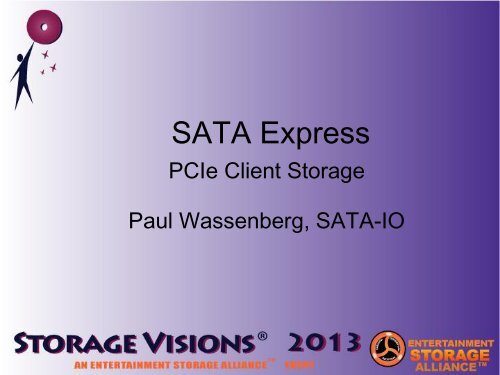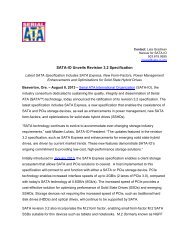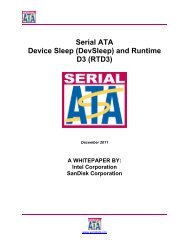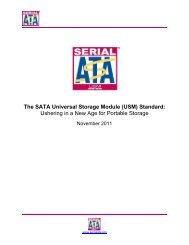SATA Express PCIe Client Storage - SATA-IO
SATA Express PCIe Client Storage - SATA-IO
SATA Express PCIe Client Storage - SATA-IO
Create successful ePaper yourself
Turn your PDF publications into a flip-book with our unique Google optimized e-Paper software.
<strong>SATA</strong> <strong>Express</strong><br />
<strong>PCIe</strong> <strong>Client</strong> <strong>Storage</strong><br />
Paul Wassenberg, <strong>SATA</strong>-<strong>IO</strong>
What is <strong>SATA</strong> <strong>Express</strong>?<br />
• Standardization of <strong>PCIe</strong> as an interface for client<br />
storage<br />
• Enables <strong>PCIe</strong> 1GB/s per lane performance for the<br />
client space<br />
• Today’s <strong>SATA</strong> = 0.6GB/s<br />
• Provides an ecosystem for client storage in which<br />
<strong>SATA</strong> and <strong>PCIe</strong> solutions can coexist<br />
• A <strong>SATA</strong> <strong>Express</strong> host utilizes a <strong>SATA</strong> <strong>Express</strong> host<br />
connector and will connect to and function with a <strong>SATA</strong> or<br />
<strong>PCIe</strong> storage device<br />
2
<strong>SATA</strong> <strong>Express</strong> is <strong>PCIe</strong><br />
• The <strong>SATA</strong> <strong>Express</strong> environment is pure <strong>PCIe</strong><br />
• There is no <strong>SATA</strong> link or transport layer, so<br />
there’s no translation overhead<br />
• Users will see the full performance of <strong>PCIe</strong><br />
<strong>SATA</strong> Device<br />
<strong>SATA</strong> PHY<br />
<strong>SATA</strong> Link<br />
<strong>SATA</strong> Transport<br />
Device Controller<br />
<strong>PCIe</strong> Device<br />
<strong>PCIe</strong> PHY<br />
<strong>PCIe</strong> Link<br />
<strong>PCIe</strong> Transport<br />
Device Controller<br />
3
Introducing M.2 from PCI-SIG<br />
(FKA NGFF)<br />
• Creating <strong>SATA</strong> <strong>Express</strong> infrastructure required<br />
cooperation between two industry organizations<br />
• <strong>SATA</strong>-<strong>IO</strong>:<br />
• <strong>SATA</strong> <strong>Express</strong> device connector supports<br />
up to 2 <strong>PCIe</strong> lanes<br />
• <strong>SATA</strong> <strong>Express</strong> host connector supports up<br />
to 2 <strong>PCIe</strong> lanes or 1 <strong>SATA</strong> port<br />
• PCI-SIG:<br />
• M.2 device connector supports up to 4<br />
lanes of <strong>PCIe</strong> or 1 <strong>SATA</strong> port<br />
• M.2 host connector supports up to 4 lanes<br />
of <strong>PCIe</strong> or 1 <strong>SATA</strong> port<br />
<strong>SATA</strong> or <strong>PCIe</strong><br />
Drive<br />
M.2 Card<br />
4
<strong>SATA</strong> <strong>Express</strong> Connectivity<br />
• A <strong>SATA</strong> <strong>Express</strong> (or M.2) host accepts either<br />
a <strong>SATA</strong> or <strong>PCIe</strong> storage device<br />
• A signal driven by the device tells the host<br />
whether the device is <strong>SATA</strong> or <strong>PCIe</strong><br />
• Works the same for <strong>SATA</strong> & <strong>PCIe</strong> drives on <strong>SATA</strong><br />
<strong>Express</strong> host and for M.2 <strong>SATA</strong>/<strong>PCIe</strong> cards/host<br />
<strong>SATA</strong> Drive<br />
Connector<br />
<strong>SATA</strong> <strong>Express</strong><br />
Host Connector<br />
<strong>SATA</strong><br />
Device<br />
<strong>PCIe</strong><br />
Device<br />
or<br />
<strong>SATA</strong><br />
<strong>Express</strong><br />
Host<br />
<strong>SATA</strong> <strong>Express</strong><br />
Drive Connector<br />
5
<strong>SATA</strong> <strong>Express</strong> <strong>Client</strong> Applications<br />
• A <strong>SATA</strong> <strong>Express</strong> (or M.2) host accepts either<br />
a <strong>SATA</strong> or <strong>PCIe</strong> storage device<br />
<strong>SATA</strong> <strong>Express</strong> Hosts<br />
M.2 is targeted at thin<br />
notebooks & tablets<br />
- 22 x 42, 60, 80, 110mm<br />
for storage<br />
or<br />
or<br />
or<br />
<strong>SATA</strong><br />
Drive<br />
<strong>PCIe</strong><br />
Drive<br />
M.2 <strong>SATA</strong><br />
Card<br />
M.2 <strong>PCIe</strong><br />
Card<br />
6
<strong>SATA</strong> <strong>Express</strong> Enterprise<br />
Connection<br />
• A <strong>PCIe</strong> drive mates with the SFF-8639<br />
connector for enterprise applications<br />
SFF-8639<br />
Multifunction<br />
Connector<br />
<strong>PCIe</strong><br />
Drive<br />
7
<strong>SATA</strong> <strong>Express</strong> Software<br />
Architecture<br />
• Although not defined by the specification, there are<br />
two choices for a <strong>PCIe</strong> storage device register<br />
interface/command set:<br />
1. AHCI, which is used for <strong>SATA</strong>, would enable a <strong>PCIe</strong> device<br />
to be compatible with <strong>SATA</strong> software environments<br />
• AHCI is supported in most major O/Ses<br />
• But AHCI is not optimized for SSD performance<br />
2. NVM <strong>Express</strong> is architected for high performance <strong>PCIe</strong> SSDs<br />
• But NVMe does not provide <strong>SATA</strong> software compatibility<br />
• Drivers for Windows, Linux, and VMWare are available at<br />
www.nvmexpress.org 8
Power*<br />
Performance<br />
<strong>SATA</strong> <strong>Express</strong> versus <strong>SATA</strong><br />
• <strong>SATA</strong> <strong>Express</strong> (2 lanes <strong>PCIe</strong> 3.0) offers 3.3x the<br />
performance of <strong>SATA</strong> 6Gb/s with only 4% increase in power<br />
• <strong>SATA</strong> <strong>Express</strong> (2 lanes <strong>PCIe</strong> 3.0) is 1.6x higher performance<br />
and consumes less power than <strong>SATA</strong> 12Gb/s<br />
1.08<br />
+10%<br />
1.06<br />
+4%<br />
1.04<br />
1.02<br />
Baseline<br />
Power<br />
+2%<br />
2.0 GB/s<br />
1.2 GB/s<br />
1<br />
0.6 GB/s<br />
1.0 GB/s<br />
0.98<br />
0.96<br />
<strong>SATA</strong> 6Gb/s<br />
<strong>PCIe</strong> 8Gb/s<br />
(1 lane)<br />
*Relative power for the on-drive controller;<br />
does not include Flash memory<br />
<strong>PCIe</strong> 16Gb/s<br />
(2 lanes)<br />
<strong>SATA</strong> 12Gb/s<br />
(if it existed) 9
Final Thoughts<br />
• <strong>SATA</strong> <strong>Express</strong> enables a migration path to <strong>PCIe</strong><br />
• A <strong>SATA</strong> <strong>Express</strong> or M.2 host supports <strong>PCIe</strong> or <strong>SATA</strong> storage<br />
devices<br />
• With the inclusion of M.2, <strong>SATA</strong> <strong>Express</strong> covers the<br />
entire range of client storage, from desktop to mobile<br />
• Connectivity with the enterprise via the SFF-8639 connector<br />
• Choice of register interface/command sets<br />
• AHCI for software compatibility or NVMe for higher<br />
performance<br />
• Currently no plan to define <strong>SATA</strong> 12Gb/s<br />
• Two lanes of <strong>PCIe</strong> provides higher performance with lower<br />
power<br />
10
For More Information…<br />
• Go to the <strong>SATA</strong> <strong>Express</strong> page on the <strong>SATA</strong>-<strong>IO</strong><br />
site www.sata-io.org/technology/sataexpress.asp<br />
• Check out the NVM <strong>Express</strong> site at<br />
www.nvmexpress.org<br />
• Download the SFF-8639 connector specification at<br />
ftp://ftp.seagate.com/sff/SFF-8639.PDF<br />
11
Announcing<br />
Marvell Dragonfly NVDRIVE<br />
• Combines Flash-backed DRAM and SanDisk<br />
m<strong>SATA</strong> SSDs to deliver performance of DRAM<br />
• DragonFly NVDRIVE eliminates SSD write cliff<br />
• 10-30X the performance of other solutions<br />
• 50X lower latency than traditional SSD<br />
• See the Dragonfly NVDRIVE in the Marvell booth













